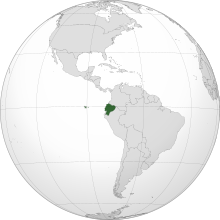Media Lengua
| Media Lengua | |
|---|---|
| Quichuañol | |
| Chaupi-shimi/ Media Lengua | |
| Native to | Ecuador |
| Region |
Imbabura Cotopaxi |
| Ethnicity | Cayambe (Imbabura Media Lengua) |
|
Native speakers
|
~2,600 (2005, 2011) |
| Language codes | |
| ISO 639-3 |
|
| Glottolog | medi1245 |
 |
|
Media Lengua, also known as Chaupi-shimi, Chaupi-lengua, Chaupi-Quichua, Quichuañol, Chapu-shimi or llanga-shimi, (roughly translated to "half language" or "in-between language") is a mixed language with Spanish vocabulary and Kichwa grammar, most conspicuously in its morphology. In terms of vocabulary, almost all lexemes (89%), including core vocabulary, are of Spanish origin and appear to conform to Kichwa phonotactics. Media Lengua is one of the few widely acknowledged examples of a "bilingual mixed language" in both the conventional and narrow linguistic sense because of its split between roots and suffixes. Such extreme and systematic borrowing is only rarely attested, and Media Lengua is not typically described as a variety of either Kichwa or Spanish. Arends et al., list two languages subsumed under the name Media Lengua: Salcedo Media Lengua and Media Lengua of Saraguro. The northern variety of Media Lengua, found in the province of Imbabura, is commonly referred to as Imbabura Media Lengua and more specifically, the dialect varieties within the province are known as Pijal Media Lengua and Angla Media Lengua.
Media Lengua was first documented in Salcedo, Cotopaxi about 100 km south of Quito, Ecuador, by Dutch linguist Pieter Muysken during fieldwork on Ecuadorian Kichwa. During Muysken's surveys of the language, he also described other highly reflexified varieties of Kichwa, including Amazonian Pidgin, Kichwa-Spanish interlanguage, Saraguro Media Lengua, and Catalangu. A 2011 investigation of Salcedo Media Lengua, however, suggests that the language is no longer spoken by the locals in and around Salcedo Canton. Little is known about the current status of the other reflexified varieties of Kichwa described by Muysken. Several investigations from 2005, 2008, and 2011, however, show that a variety of Media Lengua is currently being spoken in the northern province of Imbabura. The investigations estimate that Imbabura Media Lengua is spoken by 2,600 people, 600 in the community of Pijal aged 35 and roughly 2,000 in and around the community of Angla, typically 25–45 years of age, making Media Lengua an endangered language and moribund in Pijal. The variety of Media Lengua that is spoken in Pijal appears to have emerged at the beginning of the 20th century and had its first generation of native speakers in the 1910s. Pijal Media Lengua then spread to the nearby community of Angla in the 1950s and the 1960s through intercommunity marriages and commerce. The current status of Media Lengua in Angla appears to be slightly healthier than in Pijal with the Angla variety having been passed on, to an extent, to the 2008 generation of schoolaged children.
...
Wikipedia
